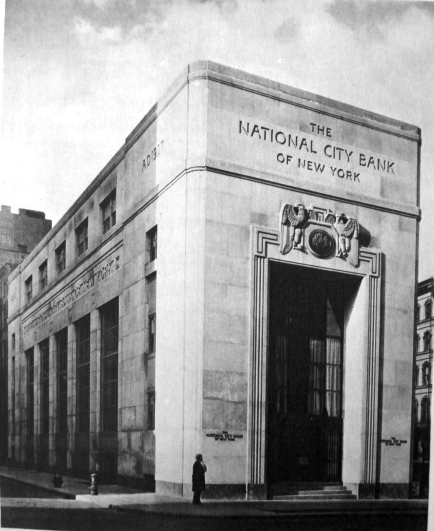 |
| 415 Broadway shortly after construction. The building embodied the principals of the new Art Deco and Art Moderne styles -- photo from author's collection |
As early as 1856 the Cozzens brothers, John and Sylvanus, ran a hotel sat on the odd little sliver of real estate between Broadway, Canal Street and Lispenard Street. As the century wore on, it became the sleazy Brandreth Hotel made infamous by its drug-dealing proprietor and at least one murder.
The Broadway-and-Canal-Street neighborhood changed dramatically in the latter part of the 19th Century, with elaborate cast iron or stone retail and office buildings rapidly being built. By the turn of the century the hotel was gone, replaced by the Brandreth Building, an “office and studio” building that was home to firms like the Hensel-Colladay Company that sold “dress, millinery and upholstery trimmings."
In 1917 the Columbia Bank opened a branch office here, to be replaced a decade later by the First National City Bank of New York.
The bank was founded as the City Bank of New York in 1812, changing its name when it joined the national banking system in 1863. The bank grew rapidly and after World War I was expanding with new branches and in October 1926 bought the Columbia Bank’s plot of land.
Architects Walker & Gillette were chosen to design the new building. Although the firm had become well-known for its neo-classical style buildings; with the coming of the Jazz Age it embraced something new: Art Deco.
For the long, narrow plot Walker & Gillette designed an Art Moderne stone block with a soaring banking area and offices above. The monumental entrance on Broadway was capped by idealized sculptures of side-viewed eagles flanking the bank’s inset seal.
 |
| Broadway and Canal Street bustle with activity in front of 415 Broadway in 1928, a year after the opening of the bank and one year before the stock market crash -- photo NYPL Collection |
Completed in 1927, the bank’s streamlined, clean lines were in stark contrast to the busy cast iron Victorian structures that surrounded it. Architectural critic for The New Yorker, Lewis Mumford, approved saying “The note of modernism pervades this structure…and is splendidly successful.”
The bank president at the time was Charles E. Mitchell and two years later he would be made chairman. National City Bank of New York was growing at an blurring pace with branches in nearly two dozen foreign countries. In 1929 it had become the largest commercial bank in the world.
Not all was rosy, however.
Mitchell’s aggressive and, some would say, questionable policies are blamed by historical economists as major influences in the stock market crash of 1929, leading to the Great Depression. In 1933 the Pecora Commission was formed; a Senate committee set up to investigate Mitchell. Committee member Senator Carter Glass reported that “Mitchell, more than any 50 men is responsible for this stock crash.”
The Depression eventually passed and the sleek bank building at 415 Broadway remained a fixture at Broadway and Canal Street. The bank changed its name again in 1955 to The First National City Bank of New York, then to First National City Bank in 1962, and finally in 1976 to Citibank, N.A.
Citibank moved out of its eye-catching building in the 1990s. Esteemed restoration architect Joseph Pell Lombardi, known for his work with numerous Manhattan vintage structures, remodeled the building for retail use.
 |
| A shoe store occupies the soaring bank space, now divided into two levels -- photo bridgeandtunnelclub.com |
Although the streamlined interior details are gone – the polished stone teller counters and the zig-zag decorated cages – the wonderful Art Modern facade of Walker & Gillette is, for the most part, intact.
.png)

Are you kidding about "Esteemed restoration architect Joseph Pell Lombardi"? The interior of the bank was even more appealing and important than the exterior. After Purchase of the building, United American Land stripped the interior, changed the entrance and opened the Canal Street facade at ground level for commercial tenants. The amazing deco chandeliers ended up in the N.Y. Law School Library. Who knows if any of the original marble walls and detailing survive under the sheetrock and dropped ceiling installed when it became Payless Shoe store a decade ago. The building now sits vacant and forlorned while the exterior is allowed to crumble. What happened to this beautiful interior and structure is a crime.
ReplyDeleteUnited American Land is a double edged sword in lower Manhattan. It holds on to (and often badly maintains) many of its sizable property holdings downtown but it also keeps most of it out of the hands of high-rise developers who will destroy the low rise character of our Tribeca/SoHo neighborhoods. This group (actually brothers) bear watching. They are unseen but powerful players.
ReplyDeleteAnd now it appears it is being torn down! I guess the brothers have their way and are making plenty of money off the property. No doubt a horrible high rise will take it's place.
ReplyDeleteSo very sad that this mess is constantly labeled "Progress", hardly any of the past preserved which we WILL come to regret, somewhere down the line. These Buildings provide REAL history, but who really cares about that to much any more?!
ReplyDeleteIn Buenos Aires, just around the corner from the main square there is a very similar building (literally same building with a different shape) built in 1929. It's still part of the Citi Bank. Around it there are lots of beautiful other buildings as well.
ReplyDelete